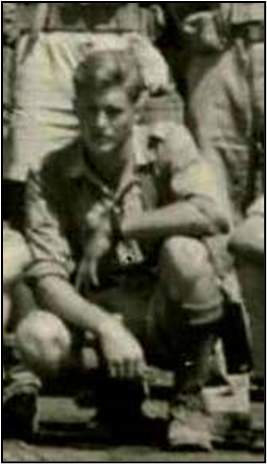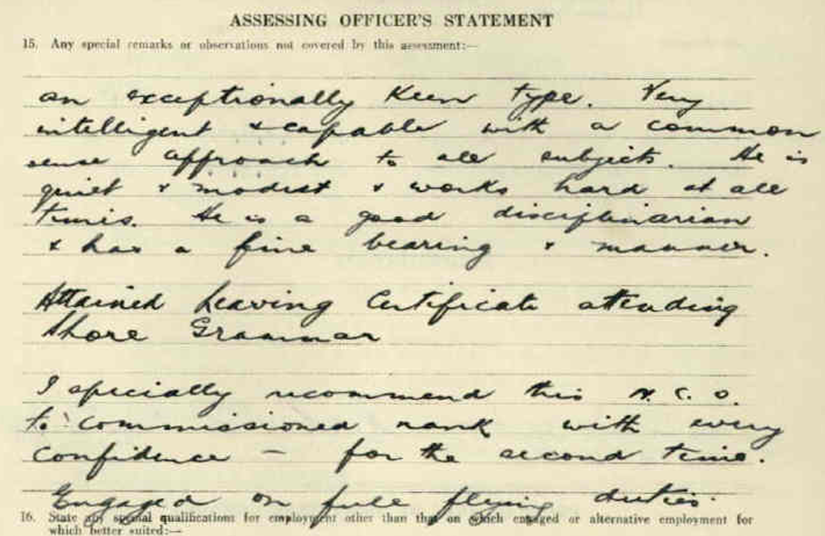FLGOFF Hugh Sutherland MacNeil 432834



| Squadron/s | 452 SQN |
| Rank On Discharge/Death | Flying Officer (FLGOFF) |
| Mustering / Specialisation | Pilot |
| Date of Birth | 04 Nov 1924 |
| Date of Enlistment | 31 Jan 1943 |
| Contributing Author/s | Compiled by Vince Conant 2017 The Spitfire Association |
He was born on the 4/11/1924 in Sydney NSW Australia. Hugh joined the R.A.A.F. On 31/1/1943 and after ITS, he underwent training at Temora, Uranquinty and finally at O.T.U., Mildura.
On 24/2/1944 he as a Sergeant Pilot, was posted to 452 Squadron, which at the time was stationed at Batchelor south of Darwin and on 31/8/1944 was granted a commission and went with the Squadron to Morotai when it moved there, a few months later.
On 7/1/1945, Hugh's Spitfire was hit by enemy ground fire whilst on a strafing sortie but he managed to bring his aircraft back to an American strip.
However, his Spitfire burst into flames in the course of a crash landing and witnesses to the event, concluded that Hugh had perished in the inferno. One U.S. Serviceman however, was certain the cockpit was empty and on scouting around, found Hugh lying unconscious in the jungle, 200 metres from the crash site.
Hugh's injuries required the attention of a U.S. Neurosurgeon, but it was the end of operational flying for him and he finished the war as a flying instructor. He was discharged on 2/9/1945.
After the war Hugh firstly got into the motor trade, but spent the best part of his working life in agriculture in the Goondiwindi District Qld. And at the same time was involved in a wide range of Community Service Organisations.
When Hugh retired in 1987, he moved to nearby Moree, where he continued his voluntary work with Legacy and the Salvos until his death.
Hugh stated that he would never cease to be amazed at the red tape in our Air Force in wartime.
In May, 1944, he was flying off the west coast of Australia, out to sea from the Drysdale River mouth. Two planes from No.1 Fighter Wing in Darwin were sent down each month to patrol the west coast and be on call if needed.
They were flying Spitfire VC's and were shadow spotting over the sea. Hugh throttled back to position his plane, but when he throttled up again, the CSU (Constant Speed Unit) had locked in fully coarse pitch. No amount of coaxing with the throttle lever had any effect on his revs. He was at 2,000 feet and estimated to be 1 to 1 ½ miles from Governor Island. He was virtually gliding with the brakes on. Fortunately, there was a narrow, sandy beach around the island, so he headed for this, deciding to belly land. He just made the end of the beach with about 300 yards of sand and a few rocks ahead of him.
The first point of contact was the 90 gallon belly tank – full – which he had forgotten to jettison. Luckily, this flew off without exploding. He was skidding along on the belly of the aircraft, unable to steer any longer, when he hit a huge rock, ripping off the left wing where it joined the fuselage.
The plane eventually settled, still upright, and to his amazement, the radio was still working. He called his partner and asked him to send out the rescue launch. In the meantime to pass the time and to let off a bit of steam, he tested his .38 revolver on the local seagulls. They were quite safe. He hit one at a distance of no more than 20 feet. It merely squawked and flew away; so much for the side-arms. Somewhere on his way back to Darwin, he lost his revolver
It was fortunate he wasn't an hour later, because by that time the beach was entirely covered by the incoming tide. He was glad he hadn't had to bale out, because the water was alive with sharks.
On arrival at the Squadron (452), the C.O. asked what happened to the plane. His explanation was accepted without question, but Headquarters, with all their red tape, insisted he was to be court martialled over the loss of his revolver. He was eventually let off, but the cost of the court martial was considerable.
58-171 F.VC JG728
Arrived in Australia on SS Asphalian 17/03/43. Rec 1AP ex UK 20/05/43. Rec 1AD ex 1AP 16/06/43. Rec 13ARD ex 1AD 04/07/43. Rec 457Sqn RAAF ex 13ARD 12/07/43. Coded ZP-A. Flying accident on 21/02/44 when flying practice low level formation flying, was forced by other a/c slipstream to collide with tree tops, but recovered to Livingstone Strip. Pilot ;F/O R L Due not injured .Rec ex 457Sqn RAAF and Repaired by 7RSU 25/02/44. Rec 452 Sqn RAAF ex 7RSU 09/03/44. Coded QY-A. Accident 0800hrs 23/05/44 when operating as Yellow 3 at Drysdale as part of 452 Sqn RAAF Detachment carrying out an Air to ground Gunnery exercise, the airscrew went into coarse pitch at 4000 feet. As the aircraft could not maintain height, so pilot glided south towards Government Island to make a wheels up landing on the beach. The aircraft stopped after skidding 30 yards on the beach. Pilot; Sgt H S MacNeil Serv#432834 not injured. Rec 7RSU ex 452 Sqn RAAF 20/06/44. Rec 8CRD ex 7RSU 30/06/44. AMSE approval to convert to components per File#9/16/1807 approved 08/08/44.
A58-440 LF.VIII JG665
Arrived in Australia on SS Mit Park 19/06/44. Rec 1AD ex UK 06/07/44. Rec14ARD Reserve Pool 06/09/44. Rec 9RSU Reserve Pool 06/12/44. Rec 452 Sqn RAAF 13/12/44.Allocated 452 Sqn RAAF 23/12/44. Enemy action, afternoon of 07/01/45 when on straffing run was hit by ground fire over Halmaheras. Hit behind in the cockpit seat, the aircraft immediately cut out but resumed. The Pilot, P/O Hugh Sutherland MacNeil Serv# 432834, assumed that his gycol lines had been damaged. He tried to nurse his aircraft back but crashed some three miles from the Pitoe Strip in heavily forested jungle at Cape Gela, Morotai NEI, 1836hrs 07/01/45.With canopy slide back, the pilot was thrown clear of aircraft on landing and was dragged away from the burning wreck by Lt John L Ranney USAAF of the 822 Bomb Squadron, 38th Bomb Group. He was sent to the 155th American Station Hospital where he underwent immediate surgery on a fractured skull and other injuries. Rec 11RSU 16/01/45. Issued for Conversion 9RSU 03/03/45.

